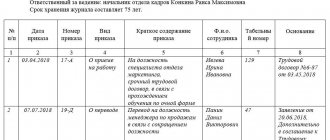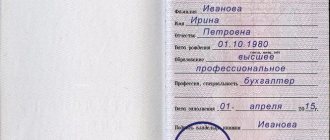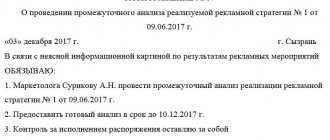Documents in personnel records management
Each organization has its own procedure for assigning numbers to personnel orders and personnel departments. Its complexity depends primarily on the number of employees. With a small staff, for example, in a startup, there is no need to divide personnel orders by type. The maximum that may be needed is to divide the papers by shelf life.
There are usually three such deadlines:
- documents on the main activities of the company are stored throughout the existence of the enterprise;
- orders (instructions) of the personnel management, information about which must be entered in work books, are stored for 50 (75) years;
- current orders for employees who are not indicated in the employee’s personal file are kept for up to 5 years.
For a small enterprise, such a separation of orders and instructions for personnel is quite sufficient.
A different situation arises in large companies, with remote divisions, branches, and a staff of several thousand people. Every day they issue many instructions and orders on the hiring of workers, dismissal, movements, vacations, business trips, etc.
If there are a large number of employees, it is necessary to further divide orders into several categories. For example, in terms of actions with personnel, departments, document storage periods, etc.
There are no generally established rules for assigning numbers to personnel documents.
At the same time, it is necessary to follow several rules for assigning numbers to personnel orders.
Rules of conduct
The registration number of the order consists of its serial number and index. The indexation of the order is determined by the individual nomenclature of cases and the rules for registering orders at the enterprise. Despite the fact that each organization prescribes its own numbering order for administrative documents, there is a certain number of general rules that firms try to adhere to. Namely:
In companies with a small document flow, there is no need to separate orders into numerous types. But they cannot be combined due to different storage periods for documents. In this case, a letter index is added to the order number through a hyphen or slash:
- “personnel” - personnel (Orders for personnel with a shelf life of 75 years);
- “k” - frames (Orders for short-term storage periods).
In organizations with a large staff of employees and administrative documents, a whole system of indexes has been developed for each type of order:
- “p” - hiring;
- “u” - dismissal;
- “pr” - hiring workers;
- “k” - business trips;
- “vk” - internal business trips;
- “zk” - business trips abroad;
- “department” - leave without pay, for pregnancy and childbirth, for child care;
- “otk” - regular vacations, study vacations;
There can be many options for numbering and index designations. Their diversity depends not only on the size of the organization, but also on the specifics of the activities of a particular company.
Numbering order
Assigning numbers to orders has certain purposes:
- Organizing all documentation.
- Speeding up the procedure for searching and recognizing documentation if necessary.
- Separation of papers depending on storage period.
The order in which numbers are assigned is not regulated in any way. The determining factor when numbering orders in personnel production is annual renewal, that is, from the 1st day of the year, numbering begins with the number 1.
Most often, the personnel service establishes its own numbering rules specific to one or another category of orders:
- For core activities, administrative and economic activities, the numbering is continuous, that is, in order (1, 2, 3, 4...).
- For personnel, the use of alphanumeric indicators is allowed (1k, 1/l, etc.). Using the abbreviations “LS” (personnel), “K” (business trip), “Pr” (hiring), it is convenient to divide orders by timing and storage order.
Consequently, each organization has the right to independently develop its own system and rules for numbering orders, while approving provisions in a local regulatory act, for example, instructions for office work. This document should be familiarized to all employees who have access to work with documents.
For the convenience of assigning numbers, it is recommended to use special accounting books (magazines).
Rules for numbering orders in personnel records management
Firstly , the default rule is that the numbering of orders and other personnel documents begins anew with the beginning of the new year. An exception to this is made for some state and municipal institutions, where the new academic year begins in September. Such organizations begin to number orders from September 1, and not from January 1.
Secondly , the numbering system used for personnel orders should reduce the time spent searching for the required paper. To do this, you can add the year of publication or the letter code of its subject to the order number.
For example, order No. 5-2018 or No. 5-otp.
In addition, if there are a large number of orders with the same content, you can keep order logs. They contain basic information about each order and disposition:
- publication number and date;
- contents of the document;
- Full name of the employee to whom it concerns and the department where he works.
Such journals can be kept either on paper or electronically in the format of a simple Excel spreadsheet.
Thirdly, reduce the time for processing and further archiving of orders and instructions. The more documents on personnel issues are generated in a company, the more ramified their classification should be and the longer the number of each order.
For example, a company’s HR department employs several employees who are each responsible for their own area of work. In order for the order signed by the director to immediately reach the employee who is responsible for sending employees, such a document is assigned a number that clearly indicates its purpose. This can be a digital or alphabetic code used to separate operations by functionality - No. 5-2018-com or No. 5-ouvol.
In general, the numbering system used should make the work of HR departments easier, so there is no need to make it cumbersome.
If in a small company with 3 employees, the functions of a clerk on personnel matters are the responsibilities of an accountant, then the extensive numbering of the manager’s orders can only confuse the employee and lead to large losses of time working with documents.
Fourthly, when creating the numbering of personnel documents, it should be similar to the procedure adopted in other departments for assigning numbers to documents. Uniformity of numbering throughout the enterprise can be achieved by creating an internal document on record keeping broken down by divisions or types of business papers, as well as a common nomenclature of files for all departments or departments.
How to number orders in personnel records
Before the start of the new calendar year, it is necessary to decide whether the current system of numbering personnel orders is satisfactory or whether changes need to be made to it. When creating a new enterprise, you can use the simplest order for numbering orders in personnel records, where each order has a one- or two-digit number.
Then, as the number of staff expands and personnel functions are transferred to a separate structural unit, it becomes necessary to divide personnel orders into several categories, which are also reflected in the number of each document, using alphanumeric encoding, depending on the general numbering system adopted at the enterprise.
When creating a numbering system and maintaining document flow at an enterprise, one must be guided by the requirements laid down in such regulations as the law on archival affairs No. 125-FZ of October 22, 2004 and order of the Ministry of Culture of the Russian Federation No. 558 of August 25, 2010.
They establish general storage periods for personnel orders, and also provide a fairly simple classification of various personnel documents. In addition, some industry departments are also developing separate provisions for document management in their subordinate organizations.
How to correctly number orders for personnel and main activities
Glafira (guest) #10[35577] February 18, 2009, 17:33 Irina wrote: I've been looking for so much, can you send me the link? please... Irina, at the top of the forum there is a “search” window, enter the word “order” into it, press the OK button (next to the right) and in front of you is a whole encyclopedia about ordering. I want to draw the moderator’s attention to this message, because: A notification is being sent... Ksyushechka As I understand it? Is this how it should be? We are in complete chaos with this, I already wrote about it. I have the following orders registered: 1. According to the fire department without-ti2. On the creation of all kinds of commissions, including certification3. Business trips4. Bonuses, incl. deprivation, financial assistance, encouragement, allowances, etc.5. Orders on transport (registration, maintenance, fuel consumption standards, etc.)6. Staffing table, incl. approval, modification, modification of work schedules7. On approval of instructions, regulations, etc.8.
- Themes:
- HR records management
- Orders
- Nomenclature of cases
Is new numbering of personnel orders mandatory from the new year? Which ones exactly? From the article you will learn:
- how orders are numbered for personnel;
- how personnel orders are numbered;
- how to number orders for core activities.
Nomenclature of cases Download in .doc Numbering of orders An order is an internal administrative document of an organization. In each organization, the process of activity requires the adoption and documentation of certain rules.
The manager signs all orders of the organization.
Numbering of orders for personnel and main activities
Limited Liability Company "AST" INN/KPP 7804491337/780401001 195198, St. Petersburg, Lenina Ave., 21, building 1, room. 309 ORDER No. 1
St. Petersburg 01/01/2016 I ORDER:
- Introduce, starting from 2020, alphanumeric indexing of administrative documents for the personnel of AST LLC using the following registration letter indices: orders for hiring an employee - P (reception); 2. orders to terminate the employment agreement (contract) with an employee - U (dismissal);3. orders to transfer an employee to another job - PR (transfer of an employee);4. orders for granting leave to an employee - O (vacation);5. orders on violation of labor and production discipline - N;6. the remaining orders are K (cadres).
- Control over the implementation of this order is assigned to the Financial Director Oleg Dmitrievich Ivanov.
General Director A.S.
https://www.youtube.com/watch?v=EQ0qIzi7kI4
Examples of indexes include:
- “ls” - orders for personnel;
- “p” - about hiring;
- “y” - about termination of the employment contract;
- “k” - about the appointment of a business trip, etc.
Orders relating to the main activities of an enterprise are usually numbered using only numbers, indexes are not used, however, an organization can also use a letter code, and no one can prohibit it from doing so. Numbers are assigned to orders in chronological order, starting with number 1.
Every year the numbering starts from the beginning. The exception is educational and cultural institutions - in them the beginning of the year for office work purposes is September 1.
This numbering simplifies the solution of issues related to searching and storing orders. This means that as long as the organization carries out activities, it is obliged to preserve documents, including orders for its main activities.
Orders for personnel also have a rather long, but still limited shelf life.
In this case, the period during which the organization is obliged to ensure the safety of documents will be determined depending on the date of creation of the document. So, if the date of creation of the document falls before 2003, orders must be stored for 75 years.
If paperwork for a document was completed after January 1, 2003, the storage period is limited to 50 years. The storage periods for documents on personnel were adjusted in 2020 by introducing Article 22.1 of the Federal Law of October 22, 2004 N 125-FZ “On Archival Affairs in the Russian Federation.”
Source: https://law-uradres.ru/kak-pravilno-numerovat-prikazy-po-kadram-i-osnovnoj-deyatelnosti/
How to number and register
The method of document numbering is chosen by the company itself, as specified in local regulations. If any changes are made, this will be reflected there. However, you can change the numbering method only from the beginning of a new calendar year.
Documents on core activities are numbered separately from personnel documentation. Numbering can be done either automatically in the working program (usually 1C) or manually.
For correct assignment, a log book (registration book) is used. It reflects the date, number, content and information about the persons who compiled and signed the order.
If the company’s document flow is large, then, in addition to numbers, it also contains alphabetic characters. Most often, letter designations are used for documents with different shelf life.
Registration can be done by entering the number, date and name in the registration log or the main characteristics in the electronic document management system.
The company itself chooses its preferred registration method. In some cases, both types are used. This is not a mandatory procedure, but is carried out for the purpose of safety and reliability.
The registration log is compiled on paper and presents a table with column names. The form of such a journal, as well as the content, is determined by the legal entity.
Numbering is done depending on the types of orders in the company. Thus, the following types of activities are distinguished:
- main;
- by personnel;
- administrative and economic.
Depending on the variety, the place in the company’s document management system, numbering, and storage period are determined.
By main activity
These include orders:
- on the creation of a company;
- on approval of the staff schedule;
- on approval of the vacation or business trip schedule;
- on the creation of separate structural divisions of the organization;
- on mergers with other enterprises;
- on reorganization or liquidation;
- others regarding the company's activities.
Orders are usually divided depending on the storage period for assigning registration numbers.
https://youtu.be/vG6BEE4El3Y
Orders regarding the main activity have a registration number consisting of numbers and symbols, or only numbers. Letter designations are mainly used for numbering personnel orders.
Personnel
These orders include all document flow regarding the employees of the enterprise. The varieties are as follows:
- about hiring for a position;
- about the transfer of an employee;
- on employee bonuses;
- about promotion;
- about dismissal;
- about disciplinary action;
- about a business trip;
- about training, etc.
In other words, all actions in relation to the company’s employees are reinforced by orders that relate to personnel records management.
Examples of numbering orders in personnel records management
The complexity of the system used depends on the annual number of personnel orders issued.
For a small organization, where the number of employees does not exceed 15 - 20 people and there is no separate employee who deals with personnel issues, and their management is entrusted to an accountant or secretary, the simplest system is used.
In it, the numbering of orders begins on January 1 of each year from No. 1 and further in order. Sometimes they add the year the order was issued - No. 1-2018.
When adding various symbols to the order number, you can use the following characters: “-”, “/” or “.”.
That is, the order number will look like this:
No. 15-2018, No. 15/2018 or No. 15.2018.
Sometimes, to simplify further archiving of orders, a code is added to the document number indicating its storage period. For example, No. 15-d will mean an order with a shelf life of up to 75 years.
In addition to numbering, they keep a log of orders on paper or in electronic form (in the form of a regular table), which will make it easier to find information about the order. The table contains basic information about the order.
For example,
| 21.01.2018 | № 2/2018 | Order of dismissal | Accountant Svirestenev M. E. |
| 02.03.2018 | № 3/2018 | Order on business trip | Director Ilnovich T. G. |
Features of number assignment
The numbering is determined by the size of the enterprise. In small organizations, you can use a simple calculation procedure: numerical and letter designation through a separating sign. The decoding of the designation will be as follows:
- Numbers. Assigned in ordinal form. That is, the number is assigned to the document in the order it was last received. The new calculation is carried out from the beginning of the calendar year.
- Letters. Is a prefix to a number. Needed to identify the form of the order, to indicate its content and group.
- Dividing sign. Serves to separate letter and number designations. The components of the index can be a dash, a dot, or a fraction.
The designation may be presented without a separating character. That is, numbers and letters are written in a continuous manner. There may be a space between characters. It is also possible not to put it down. However, it makes sense to include a separator sign, as this will make the index easier to decipher.
If the enterprise is large, numbering becomes more complicated. It is recommended to create your own notation system. All its nuances are recorded in a local act. This act must be familiarized to all employees who are involved in the preparation of personnel documentation. Otherwise, confusion is likely.
The system developed by company employees must be logical and understandable. Eg:
- Orders to impose penalties are designated by the letter “DV”.
- Dismissal orders are indicated by the symbol “U”.
The legislation does not provide guidance regarding the assignment of designations. Therefore, letter and number combinations can be completely different.
Example of numbering for medium-sized enterprises
For medium-sized companies, where work with personnel is already allocated as a separate area, it is necessary to use more complex numbering for personnel orders.
Such a system may imply the allocation of personnel orders into a separate category, then a number or letters are added to the usual order number indicating the personnel department.
For example, order No. 1-2018/k.
If each department in the organization’s document flow is assigned a serial number, then instead of a letter, the order numbering will look like this:
No. 1-2018/4, where 4 is the serial number of the personnel service.
If there is a sufficiently large turnover of documents on personnel, organizations can additionally use division for the reasons for issuing the order. This may also be indicated by an alphabetic or numeric code.
For example, No. 1-2018/4otp, which means an order to leave an employee. Or code “3” is assigned to bonus orders. Then the number might look like this:
No. 1-2018/3k, No. 1-2018/4.3 - this means that the personnel department (4 or “k”) prepared and signed an order for employee bonuses (3) from the manager, and since the beginning of the year this order was the first in the department frames (1).
Also, in medium-sized companies, it is advisable to differentiate between journals to record issued orders. Instead of one general journal, you can maintain the following types of journals:
- orders on dismissals, transfers and hiring;
- orders for sending employees;
- orders for bonuses and penalties;
- vacation orders;
- other orders and instructions for personnel.
Number assignment procedure
Let's look at the order of index assignment:
- Orders are divided into separate groups. Groups can be distinguished based on the content of the document and its storage period.
- Each of the selected groups is registered in special forms. For example, these are journals and an electronic document management system.
- To number a specific order, you need to look in the journal and check which index is assigned to the corresponding document. After this, the paper is assigned the required number.
IMPORTANT! The company definitely needs to fix its own numbering method in local acts.
Examples
The accepted numbering is recorded in the instructions. This document is an assistant to employees who manage personnel document flow. Let's look at an example of numbering:
- The symbol P indicates hiring.
- U - dismissal.
- PR – transfer of an employee to another position.
- O – vacation.
- N – violation of discipline.
- K – other personnel orders.
If an order is accepted that is not related to the above groups, you do not have to mark it with a letter designation.











